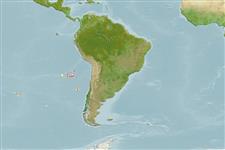>
Acropomatiformes (Oceanic basses) >
Epigonidae (Deepwater cardinalfishes)
Etymology: Epigonus: Greek, epi = over, in front + Greek, gonio = angle (Ref. 45335).
Environment: milieu / climate zone / depth range / distribution range
Ecología
marino batidemersal; rango de profundidad 230 - 500 m (Ref. 42080). Deep-water
Southeast Pacific: seamounts in the Nasca Ridge.
Tamaño / Peso / Age
Maturity: Lm ? range ? - ? cm
Max length : 15.3 cm SL macho / no sexado; (Ref. 31634); edad máxima reportada: 8 años (Ref. 31634)
Short description
Claves de identificación | Morfología | Morfometría
Espinas dorsales (total) : 7; Radios blandos dorsales (total) : 9. Opercular spine present. Pelvic fins almost reach the middle of the ventro-anal length or extend beyond it. Greatest body depth, 20.5-22.5 percent SL (Ref. 31632).
A mesobenthic-pelagic species living mainly above the bottom (Ref. 31632).
Life cycle and mating behavior
Madurez | Reproducción | Puesta | Huevos | Fecundidad | Larva
Abramov, A.A., 1992. Species composition and distribution of Epigonus (Epigonidae) in the world ocean. J. Ichthyol. 32(5):94-108. (Ref. 31632)
IUCN Red List Status (Ref. 130435: Version 2024-2)
Threat to humans
Harmless
Human uses
Herramientas
Special reports
Download XML
Fuentes de Internet
Estimates based on models
Preferred temperature (Ref.
123201): 6.9 - 11.3, mean 10.8 °C (based on 44 cells).
Phylogenetic diversity index (Ref.
82804): PD
50 = 0.5000 [Uniqueness, from 0.5 = low to 2.0 = high].
Bayesian length-weight: a=0.01148 (0.00647 - 0.02037), b=2.98 (2.82 - 3.14), in cm total length, based on LWR estimates for this species & Genus-body shape (Ref.
93245).
Nivel trófico (Ref.
69278): 3.4 ±0.0 se; based on diet studies.
Resiliencia (Ref.
120179): Medio, población duplicada en un tiempo mínimo de 1.4-4.4 años (Tmax=8; K=0.45-0.52).
Fishing Vulnerability (Ref.
59153): Low vulnerability (10 of 100).
